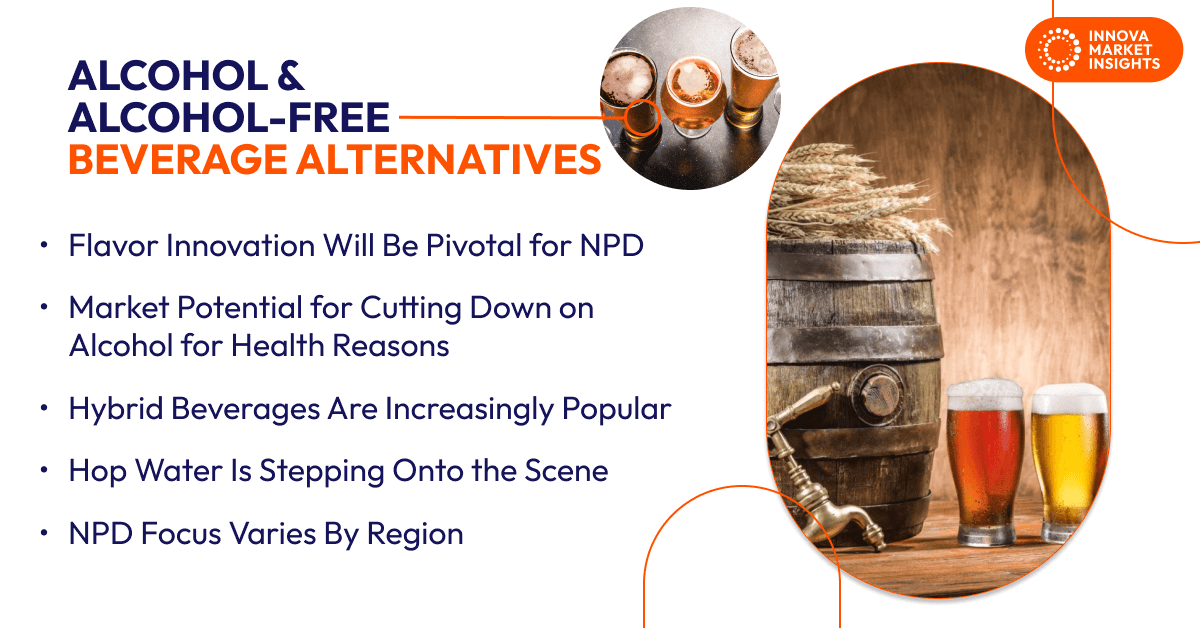February 7, 2024 – The global population is leaning into alcoholic beverage alternatives that do away with hangovers, instead focusing on the occasion and potential health benefits.
Consumer Insights
Global penetration of beverage alternatives like alcohol-free drinks varies, with the highest rates occurring in Poland, Nigeria, and Spain. Alcohol-free liquors and spirits are consumed most frequently, with just over half of consumers claiming to drink these once a week or more. Overall, 23% of consumers say they increased their consumption of non-alcoholic alternative beverages whereas 60% maintain their uptake. India, Vietnam, and Egypt are the countries that are most likely to be increasing their intake of alcohol-free beverages. Most consumers that drink alcohol-free beverages do so to relax and wind down (31%), because it is tasty (30%), and to quench their thirst (26%). When purchasing alcohol-free beverages, consumers say they are most influenced by safety and sugar claims as well as attributes indicating naturalness, though the importance of these claims varies by market.
What’s Shaping the Category?
Global new product development (NPD) in low and alcohol-free beverages is growing at +13.6% CAGR over the past five years, outpacing the overall alcoholic beverages market that has been growing at +2.6% CAGR. West Europe is the most active region in NPD at 37%, ahead of North America and Asia at 24% and 15%, respectively. However, the fastest growth in NPD is coming from Australasia. Each region suggests varying focuses for NPD: the alcohol-free spirits market holds its largest penetration in North America, where innovators are also most active for hard seltzer NPD. Meanwhile, innovators in West-Europe are targeting the alcohol-free wine market, and the flavored alcohol-free beverage market in Asia represents over half of activity there. Other areas that are gaining growth are seasonal and limited-edition products, but clean label, health, low calorie, and gluten-free claims have been catching up. Overall, unflavored beer leads, while mojito tops the flavored alcoholic beverages subcategory.

Healthier Living in Low to No Alcohol
As consumers look for ways to improve their health, reducing alcohol consumption is an approach some consumers are looking for to engage in a healthier lifestyle, while still looking for and enjoying the taste and occasion of a premium beverage. Beyond the effect of alcohol reduction, which includes lower sugar, calorie, and carb options, added functionality in the RT-flavored beverages subcategory offers further opportunities. 30% of consumers say social gatherings with family and friends are a top spending priority. However, changes in how consumers are socializing can influence what people are eating and drinking. For those who spend more time at home, low and alcohol-free options provide a treat – something that is more special or indulgent than usually – at the end of the day, week, or month. For consumers that are socializing out of the home, other factors might come into play, such as driving. They might still want to indulge in their favorite beer and spirit but without the alcohol.
Trends Impact
A number of Innova Market Insights’ Top 10 Trends for 2023 are impacting the low and alcohol-free beverage market. Unpuzzle health – defined by consumers’ appreciation and demand for simple communication that is backed by trusted certification that reinforces health messages – is a major influence. In the flavored alcohol-free beverages subcategory, this leans toward sugar reduction as well as added functionality. In markets such as North America, for example, there is greater attention on CBD and THC-infused products and added adaptogens. In low and alcohol-free beers, low carb and low-calorie claims are of great importance to consumers. Quick Quality – which describes how culinary creativity during the pandemic, which now needs to come with added convenience to meet busier routines – convenient formats are a given, but the market could witness greater attention being placed on higher-quality ingredients.
Revenge Spending – defined by the idea that small pleasures have a heightened effect as luxury spending comes under pressure, offering opportunities to enhance brand perception – sees innovators creating more pleasurable experiences such as experimental flavors and limited edition launches.
What’s Next?
Innova’s consumer research showed that more than one-third of global consumers had avoided and cut down on drinking alcohol over the previous 12 months for health reasons – which demonstrates the potential in the low and alcohol-free beverage market.
Flavor innovation will be a pivotal route to NPD development across most subcategories, exciting consumers with interesting and novel tastes. Look out for unusual botanicals, global flavors, and premium ingredients.
North America seems to be expressing interest in the area of hop water, so expect other markets’ interest to follow. Hybrid beverages are also gaining attention, think of beloved staples such as espresso martinis and vodka redbulls, now being joined by beer with coffee flavors and caffeine. Be on the lookout for further innovation.
This article is based on our insider report, “Beyond Today: Future Insights in Global Low & No Alcohol Alternatives.” If you are interested in reading this report, feel free to request a demo.
You can do this by either booking a demo or using our Contact Form.